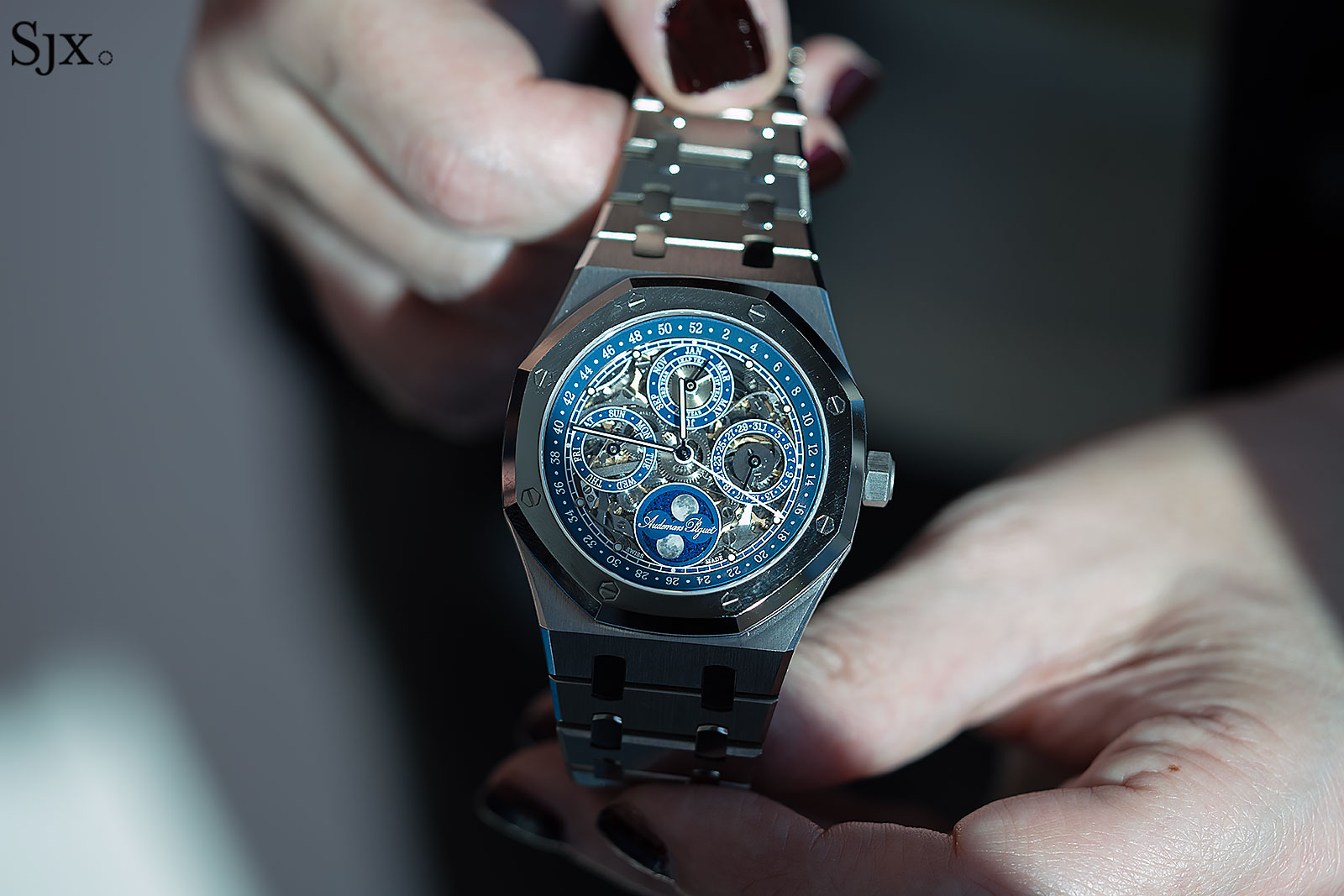First Look: Audemars Piguet Royal Oak Perpetual Calendar “150th Anniversary” Openworked
Goodbye to a long-lived calibre.
Audemars Piguet’s 150th anniversary debuts are centred on perpetual calendars (at least for now), marking the closing of one chapter and the opening of another. The ingenious new calibre 7138 perpetual calendar marks a definitive new chapter in the brand’s history, while the Royal Oak Perpetual Calendar “150th Anniversary” Openworked is the swan song for a storied cal. 2120 movement that Audemars Piguet (AP) has relied on for decades.
Presented in titanium with a polished BMG bezel, the final edition perpetual calendar is inspired by the Royal Oak pocket watch ref. 25729. This pocket watch lends its sapphire-and-blue aesthetic to the anniversary perpetual calendar, although the pocket watch was ironically powered by a manual wind calibre (as pocket watches tend to be).
The ref. 25729PT was a 20-piece limited edition with a matching platinum chain, made in 1992 for the 20th anniversary of the Royal Oak
Initial thoughts
The anniversary edition marks the end of the cal. 5134/5135 (and the preceding cal. 2120/2800), the long-lived perpetual calendar movement that AP launched in 1978. While great in its time, the movement was dated and somewhat low-tech by modern standards. The retirement of the movement is well deserved, and it is certainly going out in style.
At a distance the anniversary perpetual calendar is familiar, but up close it reveals details that make it a little bit more interesting than its peers. These include the blue ringed-sapphire dial, retro signature, and the (very) shiny BMG bezel.
The watch is a visual spectacle in several ways. Besides the customary lustrous finishing of the titanium case and bracelet, the bezel catches the light easily and gleams, while the skeletonised calibre offers a lot to see under magnification.
Admittedly it’s not drastically different from the recent versions of the Royal Oak perpetual calendar (refs. 26574, 26575, 26585), but there’s enough to set it apart. The differences are subtle but notable, and make sense in the context of this being the final edition. Attention was clearly paid to the details, one example is the typography for the calendar that was developed for this dial.
The only detail that I find odd is the vintage-inspired logo at six o’clock. While I understand the historical reference, the italicised emblem looks out of place against the modern aesthetics of the watch.
Needless to say, the new perpetual calendar is a good looking watch, and also expensive at CHF175,000. That’s about the ballpark for a skeletonised perpetual calendar from a brand like AP, but it’s still a lot of money. In comparison, the new Royal Oak with the cal. 7138 isn’t skeletonised but costs CHF88,000, making it something of a value buy as such things go.
Anniversary livery
The new Royal Oak is essentially a reworked variant of the open-worked perpetual calendar ref. 26585, but it’s special enough to do justice to the anniversary.
The most obvious feature is the polished bezel in bulk metallic glass (BMG). BMG is a novel metal alloy that AP has used sparingly for bezels on other Royal Oak models, including the “Jumbo” in platinum.
Also known as amorphous metal, BMG has a glass-like atomic structure that is the result of rapid cooling of the molten alloy. In contrast, conventional metal alloys have a crystalline structure. The advantage of BMG is hardness and toughness, which means that even though the bezel is mirror polished, it will not scratch as easily as gold or steel.
The sapphire dial sports dark blue chapter rings for the calendar, giving this a surprisingly different look compared to other Royal Oak perpetual calendars of the same generation.
The markings for the calendar are engraved and filled with white lacquer, including the italic logo at six o’clock. Reflecting the attention to detail in this anniversary edition, the text and numerals for the calendar are rendered in a serif font that was conceived for the anniversary watch (the preceding models employ sans serif fonts).
The end of a 50-year run
The 150th anniversary edition is the final run of a movement that AP has employed for almost 50 years. Then known as the cal. 2120/2800, the movement was made up of a Jaeger-LeCoultre cal. 920 base (the same movement found in the Royal Oak “Jumbo” ref. 5402) with a Dubois Dépraz perpetual calendar module on top. The calibre debuted in the classic ref. 5548 of 1978, and was later installed in the Royal Oak Perpetual Calendar that debuted in 1984.
An example of the Royal Oak Perpetual Calendar with the cal. 5134
In the 1980s, the skeletonised cal. 2120/2800SQ was added. It was only in 2015 that a major revision was done to the movement, transforming it into the cal. 5134 and skeletonised cal. 5135. Besides improvements geared towards reliability and ease of production, the cal. 5134/5135 is primarily distinguished by the addition of a week display on the periphery of the dial.
The cal. 5135. Image – Audemars Piguet
Key facts and price
Audemars Piguet Royal Oak Perpetual Calendar “150th Anniversary” Openworked
Ref. 26585XT.OO.1220XT.01
Diameter: 41 mm
Height: 9.9 mm
Material: Titanium with BMG bezel and case back ring
Crystal: Sapphire
Water-resistance: 20 m
Movement: Cal. 5135
Functions: Hours, minutes, and perpetual calendar
Winding: Automatic
Frequency: 19,800 beats per hour (2.75 Hz)
Power reserve: 40 hours
Strap: Titanium bracelet
Limited Edition: 150 pieces
Availability: At AP boutiques and AP houses
Price: CHF175,000 before taxes
For more, visit audemarspiguet.com.
Back to top.